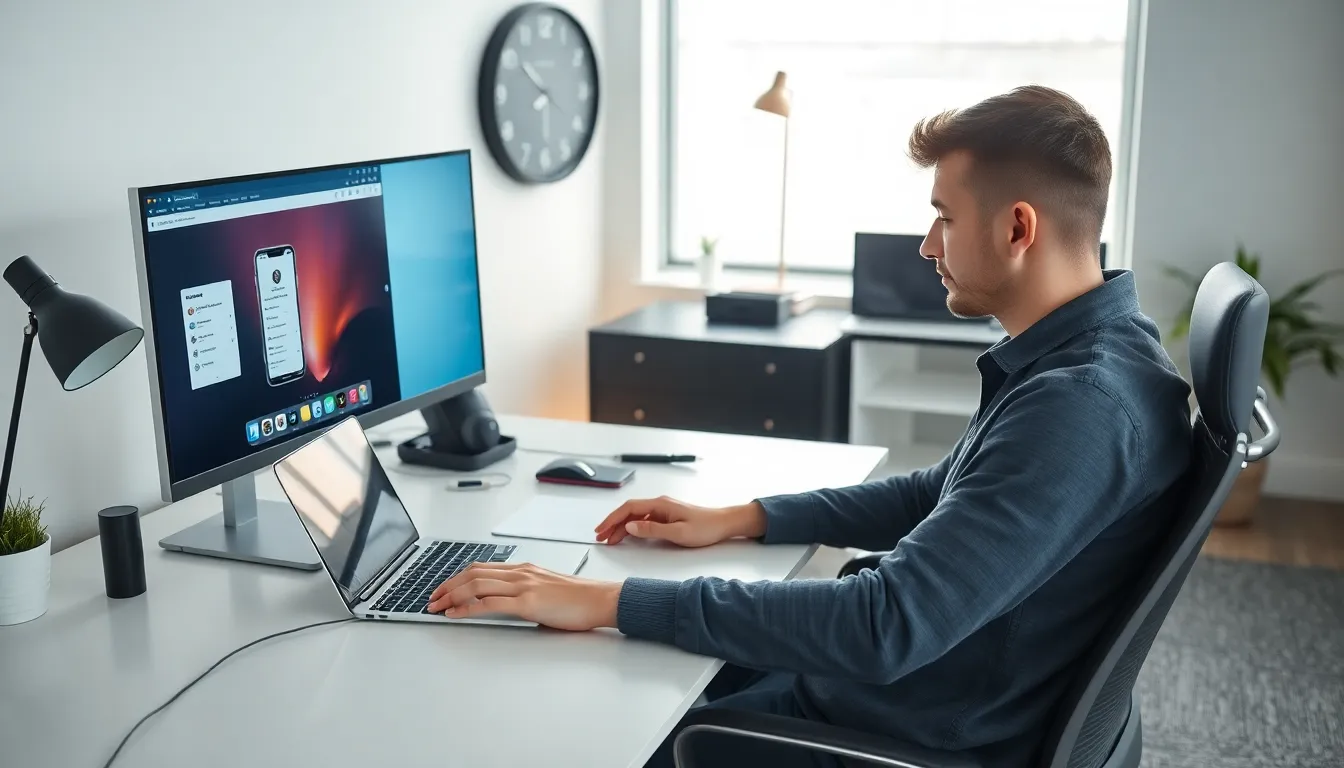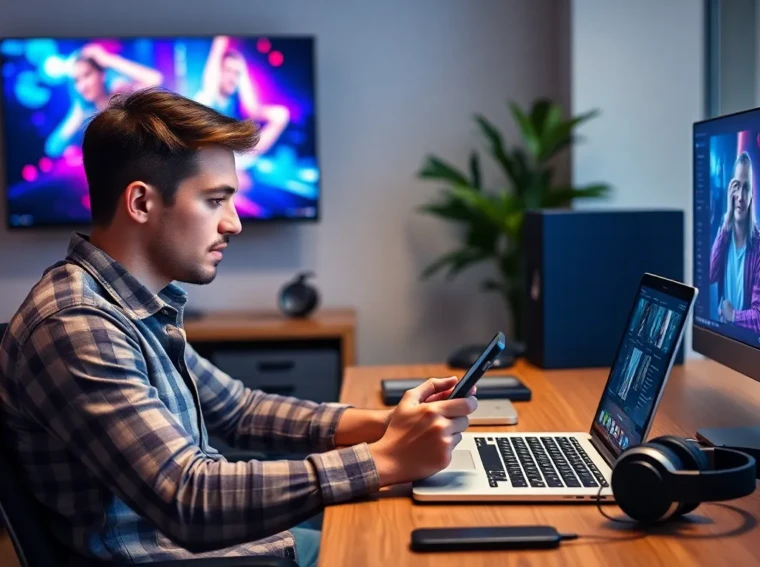In today’s fast-paced digital world, the ability to stream phone content to a PC has become a game changer. Whether it’s sharing videos, gaming, or managing apps, users are looking for seamless ways to bridge the gap between their mobile devices and computers. This integration not only enhances productivity but also enriches entertainment experiences.
Streaming from a phone to a PC opens up a world of possibilities. It allows users to enjoy larger screens, better sound systems, and the convenience of a keyboard and mouse. As technology evolves, so do the methods and tools available for this task, making it easier than ever for anyone to connect their devices effortlessly.
Understanding Phone to PC Streaming
Phone to PC streaming involves transmitting content from a mobile device to a computer. This process facilitates the display of videos, games, and apps on a larger screen while providing improved audio through PC speakers.
Methods of Streaming
- Wi-Fi Direct: Wi-Fi Direct enables direct connections without a router. Devices communicate over a common network, allowing for high-speed data transfer. This method is often used by apps that support screen mirroring.
- USB Connection: Using a USB cable connects a phone to a PC. This method often requires special software for setup. It provides a reliable connection suitable for large file transfers and streaming.
- Casting Apps: Numerous apps, like AirDroid or Vysor, allow phone screens to be mirrored to PCs. These applications simplify the connection process and provide various features, including file management.
Protocols for Streaming
- Miracast: Miracast supports wireless screen mirroring. Devices using this standard can share their screens without additional networking hardware.
- Google Cast: Google Cast allows streaming from Android devices to PCs or compatible smart TVs. Users can send content dynamically across devices on the same network.
- DLNA: Digital Living Network Alliance (DLNA) enables multimedia sharing across devices. DLNA-certified devices can stream content to PCs seamlessly.
Benefits of Streaming
- Enhanced Productivity: Users can manage multiple tasks more effectively. Streamlining tasks on a larger screen improves the overall experience.
- Improved Entertainment: Streaming games and videos utilizes the larger display and superior sound quality of PCs. Users often enjoy a more immersive experience compared to mobile screens.
- Convenience of Input Devices: Using a keyboard and mouse for navigation enhances usability. Activities like typing, gaming, and browsing become more comfortable and efficient.
Considerations for Streaming
- Network Stability: A stable Wi-Fi connection is crucial for smooth streaming experiences. Inconsistent connections can result in lag and interrupted streams.
- Device Compatibility: Not all phones and PCs support every streaming method. Checking compatibility before attempting to stream is essential.
- Security Risks: Streaming over unsecured networks poses security risks. Users must ensure that data transfers are secure, especially when sharing sensitive information.
Streaming from a phone to a PC opens opportunities for enhancing both productivity and entertainment. Understanding the methods, protocols, benefits, and considerations enables users to maximize their streaming experiences.
Benefits of Streaming Your Phone to PC

Streaming a phone to a PC offers several advantages that enhance usability and enjoyment for users. Key benefits include enhanced multitasking and improved productivity.
Enhanced Multitasking
Enhanced multitasking occurs when users stream their phones to PCs. Users can run apps simultaneously on larger screens, facilitating easier switching between applications. Notifications display directly on the desktop, ensuring users stay updated without constantly reaching for their phones. The dual display setup allows for simultaneous viewing of videos and handling of documents or spreadsheets. Users benefit from the capability to drag and drop files between devices, streamlining workflows.
Improved Productivity
Improved productivity arises from the increased screen real estate and better input options. Users can edit documents or work on presentations with higher resolution and detailed views. Keyboards and mice provide faster input compared to touchscreens, enabling efficient text entry and navigation. Collaborative tasks become simpler with the ability to share screens easily during virtual meetings, enhancing communication and teamwork. Overall, these features significantly boost user efficiency and effectiveness in managing workloads.
Stream Phone to PC
Streaming content from a phone to a PC can enhance user experiences across various applications. This section outlines effective methods for achieving this.
Using Third-Party Applications
Using third-party applications simplifies the streaming process and offers numerous features. Popular options include:
- AirDroid: This application allows for screen mirroring and file sharing between devices. Users can manage notifications and access media files directly on the PC.
- Vysor: This app supports screen mirroring with a straightforward interface. Users can control their mobile devices from the PC, making gameplay and app navigation convenient.
- Scrcpy: This open-source tool enables users to stream their Android devices to a PC without additional software installations. It boasts minimal latency, high resolution, and support for keyboard shortcuts.
These applications require both devices to connect to the same network, ensuring smooth data transfer and usability.
Utilizing Built-In Features
Many devices come equipped with built-in features that facilitate streaming. Options include:
- Windows Connect App: Windows 10 and later versions feature the Connect app, which supports Miracast. Users can cast their phones to the PC by enabling the feature in the phone’s display settings.
- Apple’s Continuity: For Apple users, features like AirPlay allow seamless streaming from iPhones to Macs. Users can share their screens or mirror content effortlessly.
- Link to Windows: This feature, available on some Android devices, allows users to connect to their Windows 10 PCs. Users can access photos, messages, and notifications directly on their desktops.
Utilizing these built-in features requires compatible devices and proper network configurations for optimal performance.
Common Issues and Troubleshooting Tips
Streaming content from a phone to a PC may present various challenges. Addressing these issues promptly ensures a smoother experience.
Connectivity Problems
- Check the Wi-Fi network: Ensure both devices are connected to the same Wi-Fi network for successful streaming.
- Verify USB connections: For wired connections, confirm that the USB cable is functional and correctly connected to both devices.
Performance Issues
- Reduce background applications: Close unnecessary applications on both devices to improve streaming performance and reduce lag.
- Adjust streaming settings: Modify the streaming resolution in the application settings for smoother playback on lower-end devices.
Compatibility Issues
- Confirm device compatibility: Ensure that both the phone and PC support the selected streaming method, such as Miracast or DLNA.
- Update device software: Install the latest software updates on both devices to avoid issues related to outdated protocols or applications.
Audio and Video Sync Issues
- Restart streaming applications: Closing and reopening the streaming app can reset the connection and correct sync issues.
- Check audio output settings: Ensure the correct audio output device is selected on the PC for optimal sound playback.
Security Concerns
- Use secure networks: Always utilize a secure Wi-Fi connection to prevent unauthorized access while streaming.
- Enable firewall protection: Ensure that the firewall on the PC allows the necessary traffic from the streaming application to enhance security.
By following these troubleshooting tips, users can resolve common issues and improve the experience of streaming from a phone to a PC, maximizing productivity and entertainment.
Conclusion
Streaming phone content to a PC opens up a world of possibilities for users seeking to enhance their digital experience. By leveraging larger screens and improved audio, individuals can enjoy a seamless blend of productivity and entertainment. With various methods available such as Wi-Fi Direct and third-party applications, users can easily connect their devices for effective multitasking.
Addressing common challenges ensures a smooth streaming experience. As technology continues to evolve, staying informed about the latest tools and techniques will empower users to make the most of their devices. Embracing this capability not only simplifies content sharing but also enriches the overall interaction with digital media.

